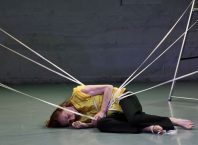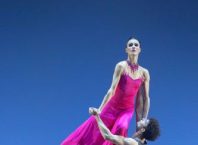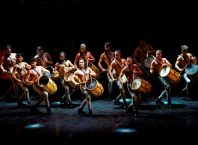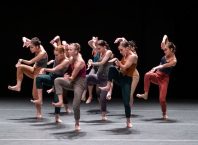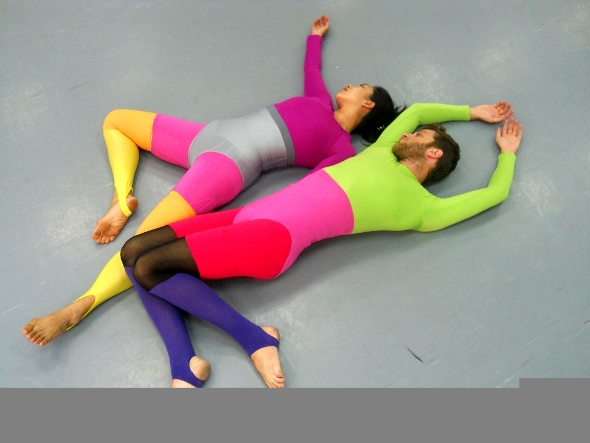
Mami Shimazaki touches mystery when she moves. “Researching movement” is a phrase often heard in relation to contemporary dance, one that often feels opaque, obscuring rather than illuminating a process. Watching Shimazaki dance in her own choreographic works, brings the viewer closer to an understanding of this research, not in words or concepts, but through the direct communication of an experience.
Shimazai presented an evening of her work in the context of Summer Dance at the Suzanne Dellal Center in Tel Aviv on August 10, 2011; Loop People (2010) and the premiere of Flood.
Loop People is a duet between Shimazaki and cellist Ran Nachmias. Loop People sets up a system of stark opposites in the movement, music, lighting, set and costume design. Nachmias, in black, opens the work in the far corner of a dimly lit stage, against a vast dark wall that appears to be made of handmade paper, curling black fibers creating a delicate texture on the surface. Shimazaki enters from the other side of the stage in a white dress, whose structured straight lines are like stiffly folded paper. Standing with her back to Nachmias, arms and legs held straight out like an automaton, she begins to move very slowly, then bends back with a sudden start. The stage fills with light and Shimazaki continues her exploration, articulating the dynamic relationships within a single body and its myriad possibilities of movement, configurations, tensions and emotion.
There is a purity and simplicity to the performance that allows contemplation of the body in relation to itself and the surrounding space, movement in relation to sound, and the two performers onstage in relation to one another. Sound and silence, light and darkness create layers of texture within the work. At one point Shimazaki performs a duet with her shadow on the wall, as she moves toward the back of the stage, her shadow is doubled. Layers and loops of movement, repeating, like the black scrawl on the wall behind her, ultimately spinning and whirling, ecstasy poised on the edge of abandon.
Flood reflects an entirely different sensibility. The intensity and inward gaze of Loop People gives way here to looser, lighter movement in a trio with Roe Efrat and Adam Kalderon. Here too, Shimazaki is fearless in her willingness to take risks – at one point allowing the stage to remain entirely empty for what feels like an awfully long time. With groovy moves and a certain humor to it, Flood would appear to be a more approachable work, yet for this writer it lacked the compelling qualities of Shimazaki’s previous works. The strongest moments in the dance occur at intimate moments, as when Shimazaki touches her face with her hands, or earlier in the work looking at her hands as if to see what they might hold. Yet these are not sufficient to anchor the work, and unlike Loop People, where there is a sense of joyous release in the final trio with Takanori Kawaharada joining Shimazaki and Nachmias, my sense is that the underlying vision here has not been fully realized.
Loop People
Choreographer: Mami Shimazaki
Dancers: Mami Shimazaki, Takanori Kawaharada
Music: Ran Nachmias
Costume Designer: Hagit Abir
Stage Set: Gali Kaner
Lighting Designer: Lior Ezra
Flood
Choreographers/Dancers Mami Shimazaki,Adam Kalderon and Roe Efrat
Video: Adam Kalderon and Roe Efrat
Costume Designer: Adam Kalderon
Lighting Designer: Lior Ezra
Music: Tzila Dagan, Portishead ,Tom Jones, Massive Attack ,Connie Francis, Black Box

